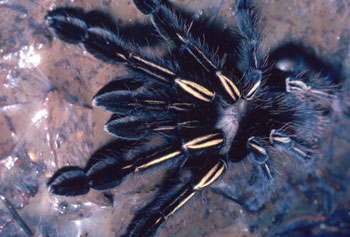In Search of Hairy Spiders
Air Date: Week of December 20, 2002
You’d think it would be impossible to link tarantulas with the idea of celebrating Christmas. But for commentator Sy Montgomery, it’s not a stretch.
Transcript
CURWOOD: Spending a night looking for a tarantula may seem more like a Halloween activity than a Christmas one. But Living on Earth commentator Sy Montgomery is just back from the rainforest of French Guyana in South America. There, she found tarantula hunting to be an apt way to celebrate the beginning of the holiday season.
MONTGOMERY: We had located the burrow: a distinctive, two-inch wide silk-lined funnel leading deep into the red rainforest soil. Such is the daytime retreat of Ephibophus murinus, the skeleton tarantula.
The lure of big hairy spiders brought me to this tropical paradise. I had just spent a week bush-bashing in the rainforest with arachnologist Sam Marshall. We had already met several tarantula species, including the Goliath bird-eater, the largest tarantula in the world. Scientists doubt that it actually consumes birds, but with its legs outstretched, it's big enough to cover your face.
We had actually handled the pinktoe tarantula, a gentle, fuzzy black spider with, yes, a dash of pink at the end of her legs. She had paced over our palms without incident. But now, on our last day in the rainforest, we hoped to see what is doubtless among the hundreds of tarantula species one of the most spectacular: the skeleton tarantula, so-named for the stunning yellow stripes on its hairy purple-black legs.

Photo Courtesy of Dr. Samuel Marshall
We marked the burrow with orange surveyor's tape so we can find it later that night. For only at night do these spiders emerge, hunting under cover of darkness.
It's a fine thing to enter a rainforest at night. Here, the darkness is warm and heavy as velvet. We're surrounded with the breath of the forest, the pulse of insects, the honk and chime of frog songs. We thread through the jungle paths and finally, we see the orange tape. And there, illuminated in the beam of our headlamps, is the skeleton tarantula. About the size of a child's hand, she sits on her throne of silk--immobile but very alert, just outside the mouth of her burrow.
It would be difficult to imagine a creature more alien. Like all spiders, she smells with her feet. She tastes with the hairs on her legs. Her skeleton is on the outside. Her blood is not red but clear. Her stomach is in her head and she digests her food before swallowing it. And yet, this creature lives on our planet.
Meeting her here in the darkness of the rainforest isn't at all frightening. Instead, it is humbling. She's magnificent. The yellow stripe on each of her eight legs reminds me of the tail of a comet. She's a starburst from the heavens, a star fallen to earth.
In an instant, she senses our movements, feeling us through subtle vibrations in the ground. With that, she disappears down into her burrow.
Oh, I say to my companion, it feels like Christmas. And why? At this time of year, we Christians rejoice that God came to us in human form. But here is God too, now, on earth among us. God comes to us here again and again, in the living forms and shapes of creatures so beautiful, so bizarre, so unlikely that, like the first Christmas, we are stunned by the unexpectedness of the blessing.
CURWOOD: Commentator Sy Montgomery is author of “Search for the Golden Moon Bear: Science and Adventure in Pursuit of a New Species.”
[THEME MUSIC]
Living on Earth wants to hear from you!
Living on Earth
62 Calef Highway, Suite 212
Lee, NH 03861
Telephone: 617-287-4121
E-mail: comments@loe.org
Newsletter [Click here]
Donate to Living on Earth!
Living on Earth is an independent media program and relies entirely on contributions from listeners and institutions supporting public service. Please donate now to preserve an independent environmental voice.
NewsletterLiving on Earth offers a weekly delivery of the show's rundown to your mailbox. Sign up for our newsletter today!
 Sailors For The Sea: Be the change you want to sea.
Sailors For The Sea: Be the change you want to sea.
 The Grantham Foundation for the Protection of the Environment: Committed to protecting and improving the health of the global environment.
The Grantham Foundation for the Protection of the Environment: Committed to protecting and improving the health of the global environment.
 Contribute to Living on Earth and receive, as our gift to you, an archival print of one of Mark Seth Lender's extraordinary wildlife photographs. Follow the link to see Mark's current collection of photographs.
Contribute to Living on Earth and receive, as our gift to you, an archival print of one of Mark Seth Lender's extraordinary wildlife photographs. Follow the link to see Mark's current collection of photographs.
 Buy a signed copy of Mark Seth Lender's book Smeagull the Seagull & support Living on Earth
Buy a signed copy of Mark Seth Lender's book Smeagull the Seagull & support Living on Earth

